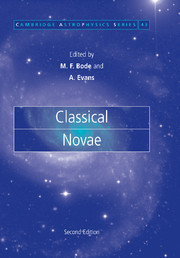Book contents
- Frontmatter
- Contents
- List of contributors
- Preface to the first edition
- Preface to the second edition
- List of symbols
- 1 Novae: an historical perspective
- 2 Properties of novae: an overview
- 3 The evolution of nova-producing binary stars
- 4 Thermonuclear processes
- 5 Nova atmospheres and winds
- 6 Observational mysteries and theoretical challenges for abundance studies
- 7 Radio emission from novae
- 8 Infrared studies of classical novae
- 9 Optical and ultraviolet evolution
- 10 X-ray emission from classical novae in outburst
- 11 Gamma-rays from classical novae
- 12 Resolved nebular remnants
- 13 Dust and molecules in nova environments
- 14 Extragalactic novae
- Object index
- Subject index
11 - Gamma-rays from classical novae
Published online by Cambridge University Press: 10 October 2009
- Frontmatter
- Contents
- List of contributors
- Preface to the first edition
- Preface to the second edition
- List of symbols
- 1 Novae: an historical perspective
- 2 Properties of novae: an overview
- 3 The evolution of nova-producing binary stars
- 4 Thermonuclear processes
- 5 Nova atmospheres and winds
- 6 Observational mysteries and theoretical challenges for abundance studies
- 7 Radio emission from novae
- 8 Infrared studies of classical novae
- 9 Optical and ultraviolet evolution
- 10 X-ray emission from classical novae in outburst
- 11 Gamma-rays from classical novae
- 12 Resolved nebular remnants
- 13 Dust and molecules in nova environments
- 14 Extragalactic novae
- Object index
- Subject index
Summary
Introduction
The most energetic photons from the whole electromagnetic spectrum are the γ-rays, with energies larger than about 10 keV, i.e. wavelengths shorter than 1.2 Å and frequencies larger than 2.4×1018 Hz. These photons trace the most energetic phenomena of the Universe and, in particular, stellar explosions such as classical novae or supernovae.
The potential of novae as γ-ray emitters was first pointed out by Clayton and Hoyle (1974). In that paper the authors stated that observable γ-rays from novae would come from electron–positron annihilation, with positrons from 13N, 14O, 15O, and 22Na decays, as well as a result of the decay of 14O and 22Na to excited states of 14N and 22Ne nuclei, which de-excite by emitting photons at 2.312 and 1.274 MeV respectively. The need for fast mixing within the nova envelope, in order to have a favorable interplay between the transparency of the expanding envelope and the short lifetimes of the radioactive nuclei (22Na excluded), was emphasized. The main ideas presented in that seminal work have remained unchanged; but some aspects have changed in the past 20 years, mainly related to new detailed nucleosynthesis studies of novae, as will be explained in this review.
Seven years later, in a new important paper, Clayton (1981) noted that another γ-ray line could be expected from novae when 7Be transforms (through an electron capture) to an excited state of 7Li, which de-excites by emitting a photon of 478 keV.
- Type
- Chapter
- Information
- Classical Novae , pp. 252 - 284Publisher: Cambridge University PressPrint publication year: 2008
- 16
- Cited by



